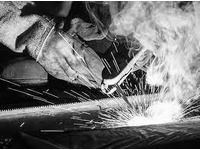About Welding
Welding is a fabrication method that involves joining materials, usually metals, by causing coalescence. This technique often requires melting the metal and adding a filler material that forms a puddle of molten material that cools to become a strong joint. Various energy sources exist for welding, including a gas flame, an electric arc, a laser, an electron beam, friction, and ultrasound.
The four most prevalent types of welding are shielded metal arc welding (SMAW), Gas metal arc welding (GMAW/MIG), flux cored arc welding (FCAW), and gas tungsten arc gas welding (GTAW/TIG).
- Shielded Metal Arc Welding is also known as stick welding. It's a manual welding process that utilizes a consumable electrode covered in flux that lays the weld.
- Gas Metal Arc Welding is an automatic welding process that uses a shielding gas and wire electrode to create the weld. It has a high welding speed and excellent efficiency.
- Flux-Cored Arc Welding is similar to MIG welding but uses a special tubular wire filled with flux. It can be used with or without a shielding gas, making it a versatile welding method.
- Gas Tungsten Arc Gas Welding uses a non-consumable tungsten electrode and a separate filler material. It's known for producing high-quality, clean welds, particularly on thin materials.
Gas cylinders play a pivotal role in the welding process, serving as the source of protective gases. These gases shield the welding area from atmospheric elements like oxygen and water vapor that can cause defects in the weld. The gas, stored under high pressure in the cylinder, is regulated and released to envelop the arc, ensuring the molten metal is protected. The resultant weld is solid and defect-free. Various gases or combinations depend on the specific welding technique and materials involved.
Welding requires appropriate protective equipment due to the inherent risks involved. Essential gear includes a welding helmet with auto-darkening features to safeguard the eyes from intense light and flying particles. Welding gloves, crafted from durable and heat-resistant materials like leather, protect hands from heat, sparks, and sharp edges. Additionally, welders should wear fire-resistant jackets or aprons to shield their bodies and safety boots to guard their feet from falling molten metal or heavy objects.
MRO Supply offers welding equipment and safety gear to meet your individual needs. And since our products come from only the most reputable manufacturers, you can trust MRO as your one-stop shop for all your welding products.






